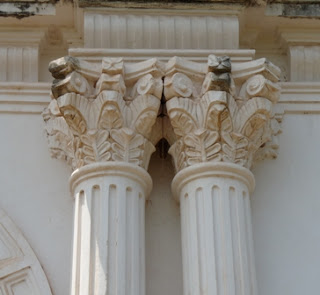On one of our wanderings and sometimes
drives on sundays, we came across this historic, magnificent and massive church
called St.Ana church or Saint Anne church or Santana, Talaulim, Goa.
It is set against the backdrop of Santana
hill, and in the foreground is the river Curca. From the top of the hill, one
can see both the twin towers of the church and the river and the fields on
either side. It is a very picturesque setting.
It is not as well kept or well known as the
Basilica of Bom Jesus or Ce Cathedral, but it is believed to be the largest
surviving monument of its kind in Asia. Constructed in 16th. century with
laterite stone, lime and mud plastering, the church is showing signs of ravages
of time.

Front elevation
Twin towers of 5 floors each soar into the sky, symmetrical on the central axis.

Side elevation

World Heritage Monument
There is a small declaring the church to be a world heritage monument. It has to be verified.

Main doors
The main entrance doors are grand with double columns on either side.

Column capitals
The capitals on the columns resemble those of Greek style, but not quite the same and the detailing is not quite so refined. I have not found this style of capitals on other churches in Goa.

Exterior window
The above photograph depicts one of the window designs on the exterior walls. They did not have the luxury of glass those days; instead they used sea shells. Sea shells allow light but keep the glare out. They are freely and abundantly available on the beaches in Goa. Also notice the borders around the window shutters!

Ceiling over the foyer

Detail of Ceiling
A high arched ceiling over the entrance foyer is interesting with fascinating patterns, still holding admirably after 400 odd years.

Interior view of the church

The Altar
Intricate Carvings on the walls in lime and mud plastering adorn the interior walls.
St. Ana Church is close to Goa Velha, and it is a beautiful church. If you are in Goa, it is a must see. 












